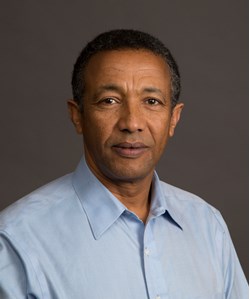Museum Curator Recognized on Nature Top 10 List

The Cleveland Museum of Natural History’s Curator of Physical Anthropology, Dr. Yohannes Haile-Selassie, has been named one of this year’s “10 People Who Mattered in Science” for his groundbreaking work in human origins in a special edition of the prestigious scientific publication
Nature.
His discovery of a 3.8-million-year-old “remarkably complete” hominin cranium—named “MRD,” short for its collection I.D., MRD-VP-1/1—was first announced by
Nature online on August 28, 2019, with a print publication date of September 12, 2019.
“The Cleveland Museum of Natural History is proud to be at the forefront of the study of human origins,” says Sonia Winner, President and CEO of the Cleveland Museum of Natural History. “The invaluable research of Dr. Yohannes Haile-Selassie continues to fill in the picture of our place in the natural world and answer the fundamental questions of who we are and where we came from.”
Now, Dr. Haile-Selassie joins internationally recognized change agents including Swedish teenage activist Greta Thunberg and Brazilian physicist Ricardo Galvão on this exclusive list curated by
Nature.
“
Nature’s 10 is not an award or a list of the most important people in science,” notes Rich Monastersky, Chief Features Editor at
Nature. “Rather, the stories of these ten people illuminate some of the most significant scientific events of 2019 across a range of issues spanning from our deep origins to the future of the world. Our list explores some of the year’s most important moments in science by highlighting people who had key roles in those events.”
In many cases, these moments only give us a glimpse of the depth of incredible work from these bright minds. Such is the case with Dr. Haile-Selassie, who has been searching the Woranso-Mille study area in Ethiopia—which he dubs “the cradle of humankind”—for clues to human origins for the past 15 years.
Here, he has collected over 12,600 fossil specimens representing about 85 mammalian species. The growing fossil collection currently includes about 230 fossil hominin specimens dating to between over 3.8 and 3 million years ago. But this latest discovery was beyond anything the researcher had hoped to find at the site.
“This is a game changer in our understanding of human evolution during the Pliocene,” says Dr. Haile-Selassie of the discovery. “It was a eureka moment and a dream come true.”
The Significance
The discovery of MRD and its resulting analysis have been invaluable to our understanding of hominin evolution. The rare, remarkably complete specimen gave us the first glimpse of the face of A. anamensis, the oldest member of the genus Australopithecus and ancestor of the famous A. afarensis specimen, Lucy.
The reconstruction of MRD also helped the research team solve a decades-old mystery. The distinct differences between the 3.8-million-year-old MRD specimen and a previously unassigned 3.9-million-year-old hominin cranium fragment—the Belohdelie frontal, discovered by a team of paleontologists in 1981—proved significant. The Belohdelie frontal appeared to share more characteristics with Lucy’s species, indicating that this specimen belongs to A. afarensis.
Using this evidence, combined with MRD’s age, Dr. Haile-Selassie and colleagues upended previous theories about the nature of hominin evolution. Researchers once believed the transition from A. anamensis to A. afarensis was a linear process, called anagenesis. This theory postulates that A. anamensis died off and gave rise to the newly evolved A. afarensis. However, thanks to this groundbreaking research, we now know the two species overlapped for at least 100,000 years, thus disproving the hypothesis of anagenesis in this lineage.
MRD is a once-in-a-lifetime discovery that has received widespread recognition from media and the scientific community. But Dr. Haile-Selassie has no plans to stop now that he’s shared this game-changing research with the world.
“Because this is really an important specimen, it would help to actually find, for example, the thigh bone or part of its feet, to understand its locomotor adaptation—how it was moving about the landscape when it was alive,” says Dr. Haile-Selassie. “We plan to go back, probably in a couple of years just to give it some time to erode, and see if there's anything new that would help us better understand the paleobiology and paleoecology of A. anamensis 3.8 million years ago.”
Facial reconstruction by John Gurche made possible through a generous contribution by Susan and George Klein.